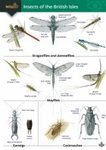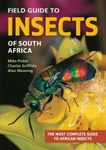Field / Identification Guide
By: Paul D Brock(Author)
542 pages, 2900 colour photos, 2100 colour distribution maps
Paul Brock's popular insect guide returns in an expanded edition, now covering over 2300 species. This is the go-to photographic field guide for British insects.
![A Comprehensive Guide to Insects of Britain & Ireland A Comprehensive Guide to Insects of Britain & Ireland]()
Click to have a closer look
About this book
Customer reviews
Related titles
About this book
This new and expanded edition, the most complete guide to insects ever published, now has 544 pages and covers over 2,300 species with updated maps & over 2,900 colour photographs throughout, with fully comprehensive sections on all insect groups, including beetles (108 pages), flies (100 pages), ants, bees & wasps (86 pages).
The main aim of this field guide is to provide clear photographs of a wide range of insects to assist in identification of the majority of insects likely to be encountered, as well as aid conservation and encourage new recorders. The concise text gives information on behaviour as well as their present-day conservation status; pointers are given to help avoid misidentification with species of similar appearance, whilst avoiding highly technical keys – the latter may, however, be vital for some families such as tiny look-alike species and the introductory text to orders gives some guidance on this.
Serious naturalists will welcome notes on areas to look for rarities, in order to watch or photograph them and information on where to look for additional information on particular insect groups. Many photographs show fascinating, sometimes seldom observed behaviour of insects; marching around a site will rarely reveal this type of activity, but methodical searches and observation will reward those with time and patience.
With its wide species coverage and emphasis on not only popular but somewhat neglected insect orders, this book will be of interest to naturalists throughout Britain, Ireland and Europe.
Customer Reviews (3)
-
It has a very tiny font so I couldn't read it
By
Nicholas
15 Jul 2020
Written for Flexibound
It has a very tiny and pale font so I couldn't read it, had to send it back. Even with reading glasses it was useless.
34 of 55 found this helpful
-
Was this helpful to you? Yes No
-
Comprehensive, useful and compact.
By
Samuel
4 Oct 2020
Written for Flexibound
A comprehensive, easy to use guide. The colour photos are generally very good for identifying insects in the field and the text, although necessarily brief, is very useful. I haven’t found any other field guides that cover so many UK species. A couple of insect groups (including mayflies) are not covered in full, but overall I don’t think you’ll find a more comprehensive and useful field guide to insect identification. I highly recommend this text.
32 of 36 found this helpful
-
Was this helpful to you? Yes No
-
A very useful photographic guide
By
Ian
22 Jul 2022
Written for Flexibound
I have the 2014 edition of this book and have found it very useful. The photographs are clear and the distribution maps aid in identification. I was a little surprised that the Warble Flies, Hypoderma sp., were excluded. I live in a rural area of Wales and the maggots of these flies are an important and notifiable problem in cattle and sheep here. Perhaps this revised edition has corrected this omission.
6 of 9 found this helpful
-
Was this helpful to you? Yes No
Field / Identification Guide
By: Paul D Brock(Author)
542 pages, 2900 colour photos, 2100 colour distribution maps
Paul Brock's popular insect guide returns in an expanded edition, now covering over 2300 species. This is the go-to photographic field guide for British insects.
"Magnificent [...] a tour de force"
– Dr George McGavin
"It blows the other field-guides out of the water"
– Dr Ross Piper
"This new field guide to insects is billed as the most comprehensive ever, and for once this is no exaggeration. I think that the claim is justified. No fewer than 2100 species are described and illustrated, with well-printed colour photographs. Opposite each bank of pictures, the text, pruned down to essentials, provides a short description and details of habitat, season and distribution (with maps) of each species. [...] Sensibly enough, no attempt is made to illustrate tiny or critical insects such as fleas, lice, thrips and gnats, for which only a token species or two are shown. But certain other groups are given unexpectedly short shrift, notably mayflies and caddisflies, beloved of anglers (fortunately, the Collins guide to freshwater life does justice to them), More space might usefully have been offered to micro-moths and aquatic bugs. Whether or not it is really possible to identify some of these beetles, flies and small bees from photographs alone I leave to the experts to decide. [...] Amassing nearly 3000 sharp and well-lit images of often scarce and elusive insects is a feat in itself. When they are arranged in a skilfully organised text conveying almost the full diversity of insect life in Britain and Ireland, the result is a quiet masterpiece. I doubt whether any of the big publishers could have brought it off. If you want to identify as many insects as possible without killing them, this book is now the obvious starting place. It is an incredible achievement."
– Peter Marren, British Wildlife 25(6), August 2014





































